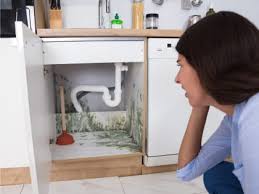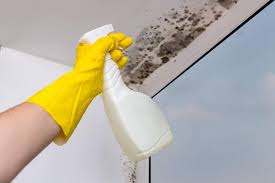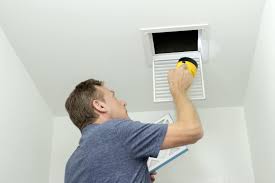Do I Need a Mold Inspection?
Mold! The very thought of it gives homeowners concern and leaves them wondering whether lurking moisture might be putting their homes and health at risk. Here are some tips from highly rated mold remediation experts on what you need to know before calling in a professional and what to expect from the job.
Keep it dry
Any place moisture tends to collect can present a risk for mold. The key to mold control is moisture control Most often finds mold in moisture-prone areas that homeowners don’t frequent, such as basements and attics, followed by kitchens and bathrooms. He also notes windows with poor caulking frequently develop mold.
Use a dehumidifier in your home, especially in cold climates. “Be diligent about using your bathroom exhaust fans during and after bathing. I often see mold developing on the ceiling above a bathtub where condensation has formed after a bath.”
Watch those exterior walls
Homeowners don’t often consider the extent to which placing things against exterior walls creates a mold risk, especially in cold climates.
If you’ve got a sofa right up against an exterior wall and you can see the sofa’s profile when you move it away from the wall, that’s mold. “When you put something up against an exterior wall, it inhibits air circulation. Closets are a big problem, too. People will shove boxes and clothes up against an exterior wall, close the closet and forget about it.”
Use your senses
Odds are, you’ll smell mold before you see it. “There’s a distinctive, musty odor to mold. When people can’t tell where the mold smell is coming from, he advises them to turn off the HVAC system at the beginning of the day, wait a few hours, close all the doors and go room by room to find the strongest odor.
Check their qualifications
Licensing laws vary from state to state, so check your local regulations and make sure your mold contractor holds the proper licenses. In some states, the inspector who detects mold cannot also be the contractor who remediates it, so be aware of those rules as well. Also ask whether your contractor is certified by reputable groups such as the Institute of Inspection, Cleaning and Restoration Certification or the National Organization of Remediators and Mold Inspectors.

WHAT TO DO WHEN YOU HAVE BLACK MOLD
Something smells off in your basement. You begin moving boxes and then you notice it growing up your wall – black mold. Oh no! You begin to panic as you realize that everyone in your house has been battling the cold and flu off and on for months. Now you can’t help but wonder if your home has been making your family sick
Where Does Black Mold Come From?
No matter how often you clean, odds are you still notice small amounts of mold in your bathroom, basement, attic or laundry room from time to time. This is normal. Mold spores are everywhere, and there is no way to completely eradicate them. Most of the time they fly into your home from the air, on your clothing (or shoes) or even your pet. Normally they don’t cause a problem; unless they find a warm, moist area to settle in and reproduce. If left to grow unnoticed, mold can be difficult to get rid of. A serious mold problem is usually the result of a leak or flood, which allows spores to grow unnoticed. Maybe a small leak goes unnoticed in the basement, allowing moisture to build up in the walls, drywall, fabrics (like stored clothing), books, etc. Mold spores are attracted to the moisture and will begin to grow.
How Can You Tell If the Mold in Your Home Is Dangerous?
You’ve noticed some type of black and green mold growing in your home. Now what? You can’t tackle the problem until you know what kind of mold you are dealing with. The only surefire way to determine if the black mold growing is indeed toxic mold is to send a sample to a laboratory for testing. Once you have the results, you can determine if it is something you can clean yourself, or if you need to bring in a mold remediation specialist.
How Mold Remediation Works
Finding mold in your home can be scary – especially if you find a lot of it. That is when bringing in someone who knows how to safely remove mold can be helpful. During the remediation process, a specialist will determine the type of mold infiltrating your home, and then safely remove it while safeguarding the rest of your home; and finish by clearing the air of spores so that the problem does not return. Here are the basic steps to mold remediation:
- Inspection: During your home’s mold inspection, the specialists will determine the severity of the problem including what areas spores have infiltrated and what type of mold has been found.
- Containing mold growth: Mold can grow quickly under the right conditions. Plus it can move through the air, putting other areas of the home at risk. The first step to mold removal is to seal off the contaminated area to prevent the mold from spreading.
- Controlling Moisture: Since mold spores thrive in a moist environment, the next step to clearing the area of mold is to get rid of any leaks or other moisture problems.
- Cleaning the mold: Once the area is completely dried, HEPA vacuums can be used to remove mold spores form the area (including the air), while the infected surfaces are cleaned.
- Cleaning the air: Since mold spores move through the air, it is vital that home’s that have been infiltrated with black mold also have their ducts, furnace and air filters thoroughly cleaned to remove all spores from the home.

What health problems are caused by mold mildew?
Exposure to environmental fungi like this one can lead to skin irritation, breathing difficulties, allergic reactions and headaches. The spores can be an irritant, causing a burning sensation to the skin, lungs, nose, throat or eyes.
Some fungi can trigger asthma attacks in people who are allergic. Even non-allergic asthma sufferers may experience worsened symptoms due to exposure. Symptoms of allergic reaction include sneezing, red eyes, runny nose or the appearance of skin rash.
The EPA reports that repeated exposure to this issue can bring about increased sensitivity to allergies and health problems. That’s why it is important to put an end to the issue as soon as you find it.
Molds can also produce mycotoxins, which are toxic substances found either within or on the surface of spores. They can enter a person’s system via ingestion, inhalation or skin contact. Aflatoxin B1 is the best-known mycotoxin. It is a potent carcinogen and inhaling it can cause lung cancer. The fungi Aspergillus parasiticus and Aspergillus flavus produce this carcinogen.

How to Prevent Mold
Learn strategies to prevent rot from ruining your health and your home
Anyone involved in the construction, maintenance, selling, insuring or purchasing of a new home (in other words, just about everyone) has probably heard more about the dangers and costs of mold than they care to. But the fundamental risks associated with the potential of a mold problem remain: mold can lead to rot, compromising the home’s durability. And toxic mold varieties can cause health hazards. As insurance companies seek ways to limit their liability, and homeowners become more aware and sensitive to the issue, the builder or remodeler is often caught in the crossfire.
The best practice in building a comfortable, durable and safe home is to adopt a mold resistance strategy that includes products, process and job site management.
Here are a few suggestions to get you going:
- Keep all wood studs dry, and check inventory to make sure it’s being stored appropriately.
- Allow framing to dry before putting up drywall. Mold can begin to grow on wet surfaces within 48 hours, so the home could have a mold issue even before the homeowners move in.
- Use mold-resistant drywall and paints, especially in bathrooms and kitchens.
- Install ventilation fixtures in the bathroom and kitchen. Make sure these are vented to the exterior.
- Waterproof the home to prevent bulk water intrusion. This means everything from kick-out flashing on the roof to French drains in the foundation.
- New methods, technologies and products are hitting the market every year, so take advantage of free information from government programs to keep up to date.
Benefits of Mold Inspection & Removal Pros
Price alone should not be your only consideration. DIY removal may not take care of the underlying problem, and only focuses on the spots you already know about. You might also clean growth in a way that still leaves toxic traces behind.
Hiring an expert costs more but comes with a wide range of benefits:
- A comprehensive inspection that detects traces of growth throughout the home.
- A long-term solution that fixes not just the symptoms, but the underlying issue.
- Expertise and advice in how to avoid future problems.